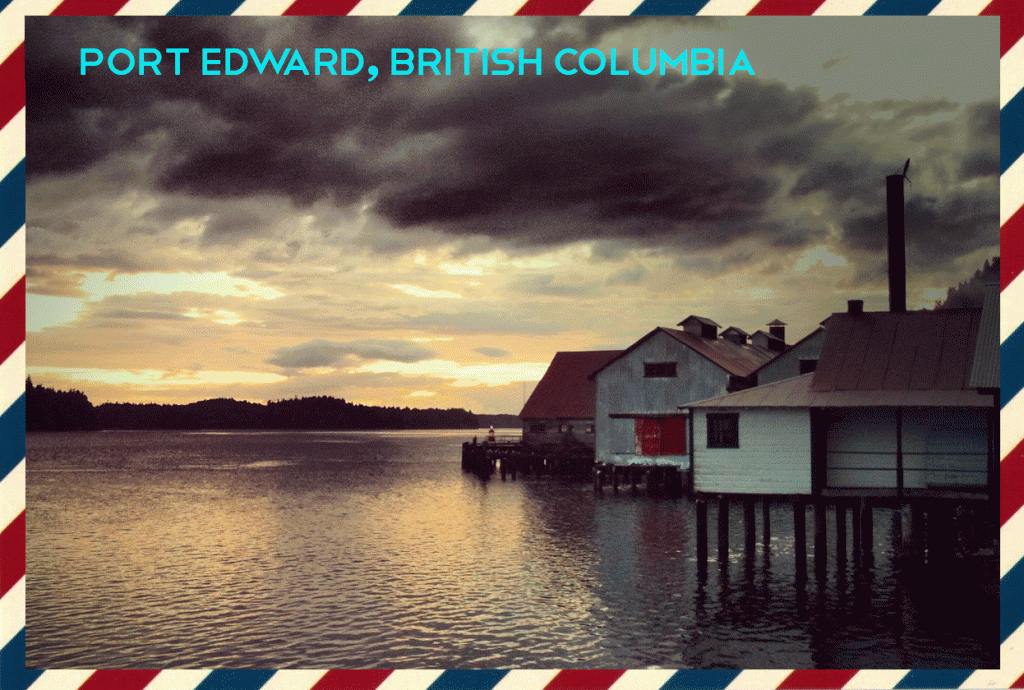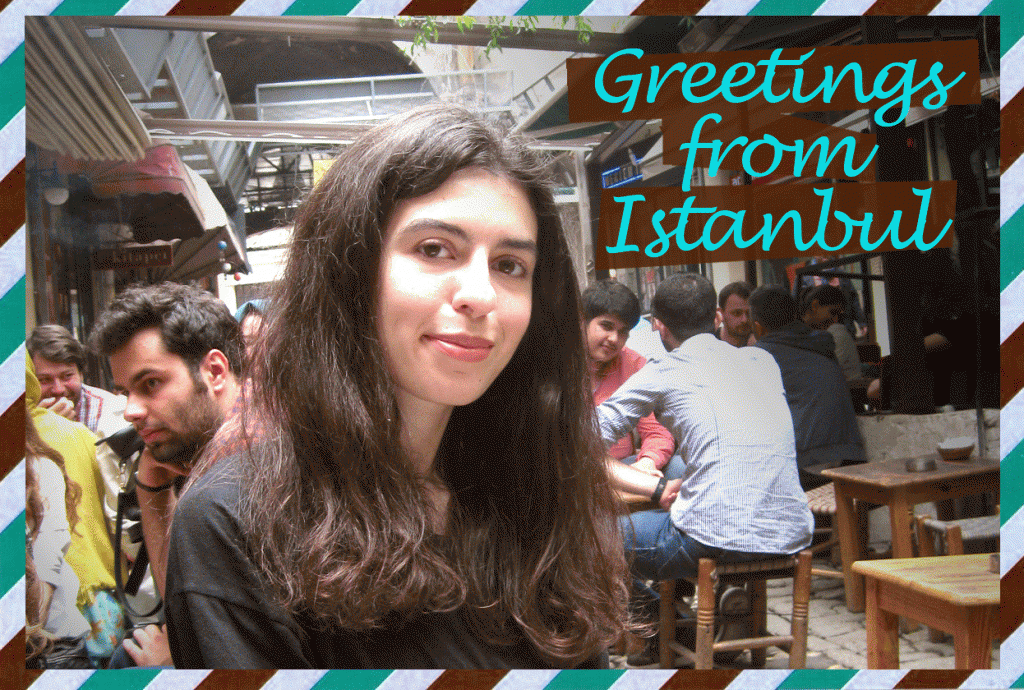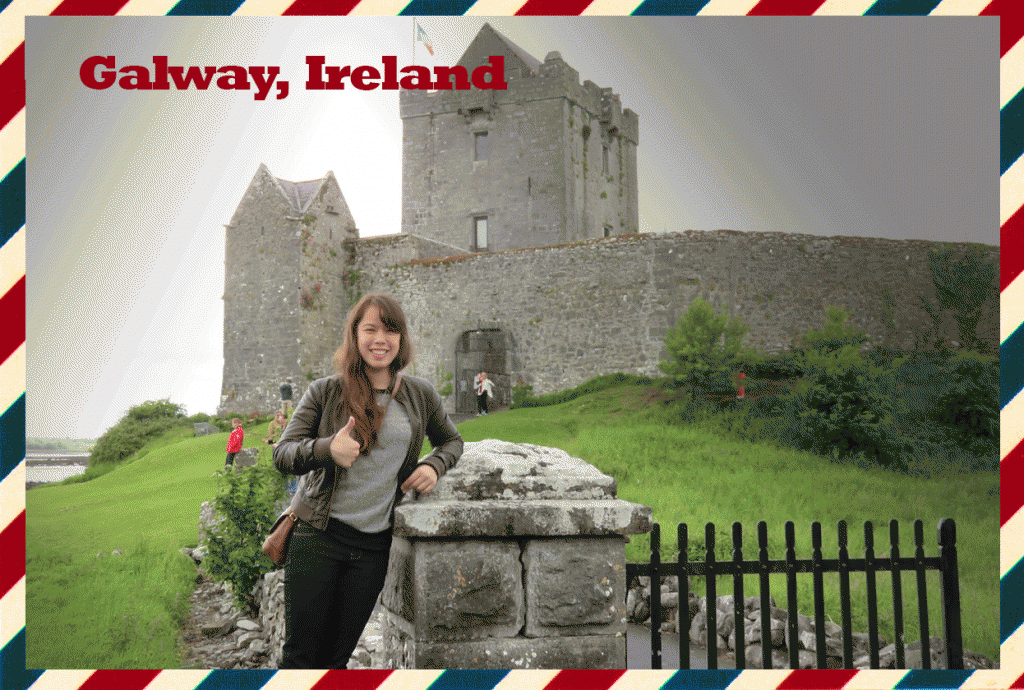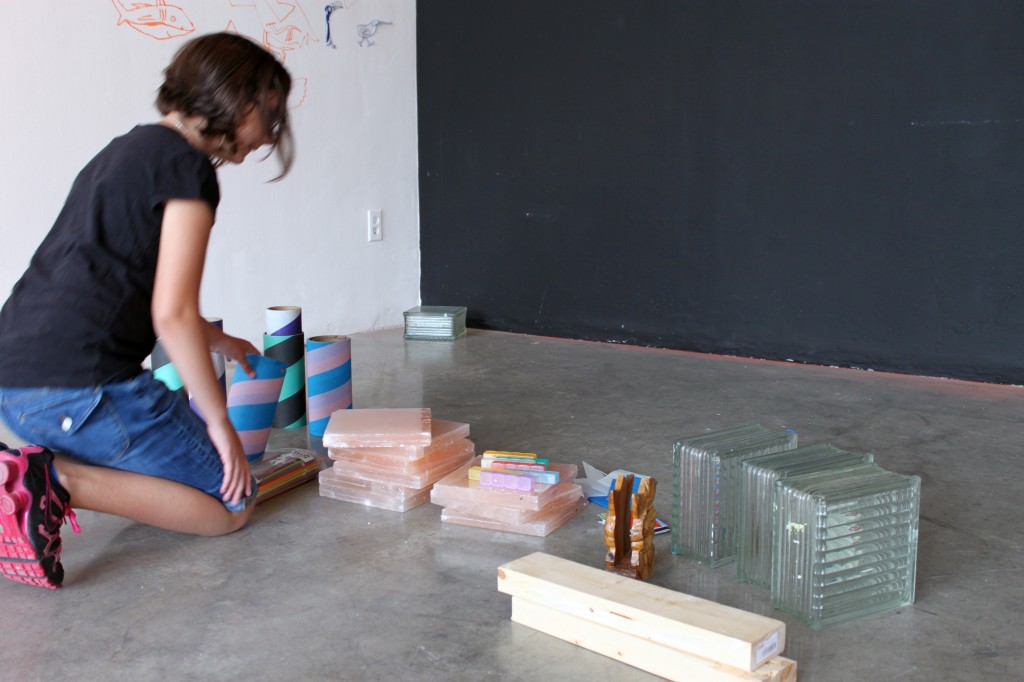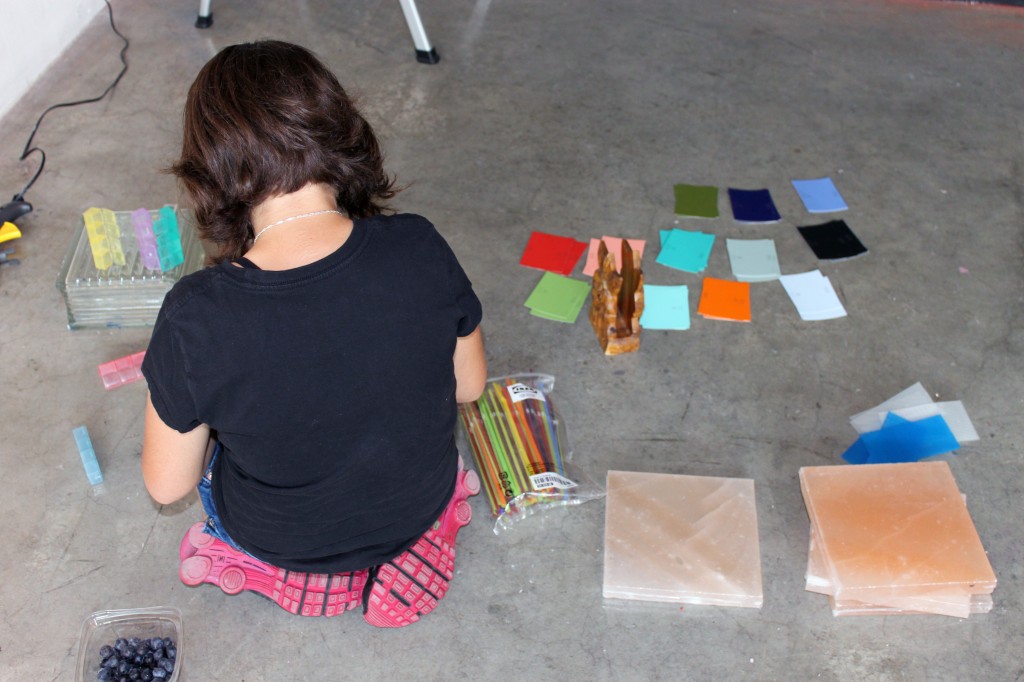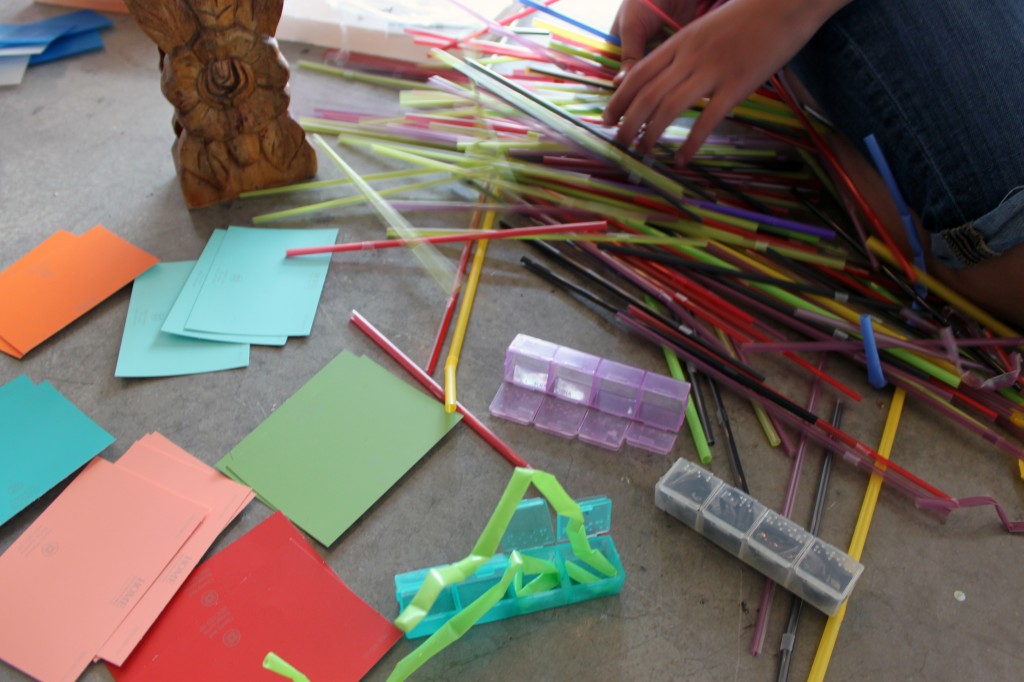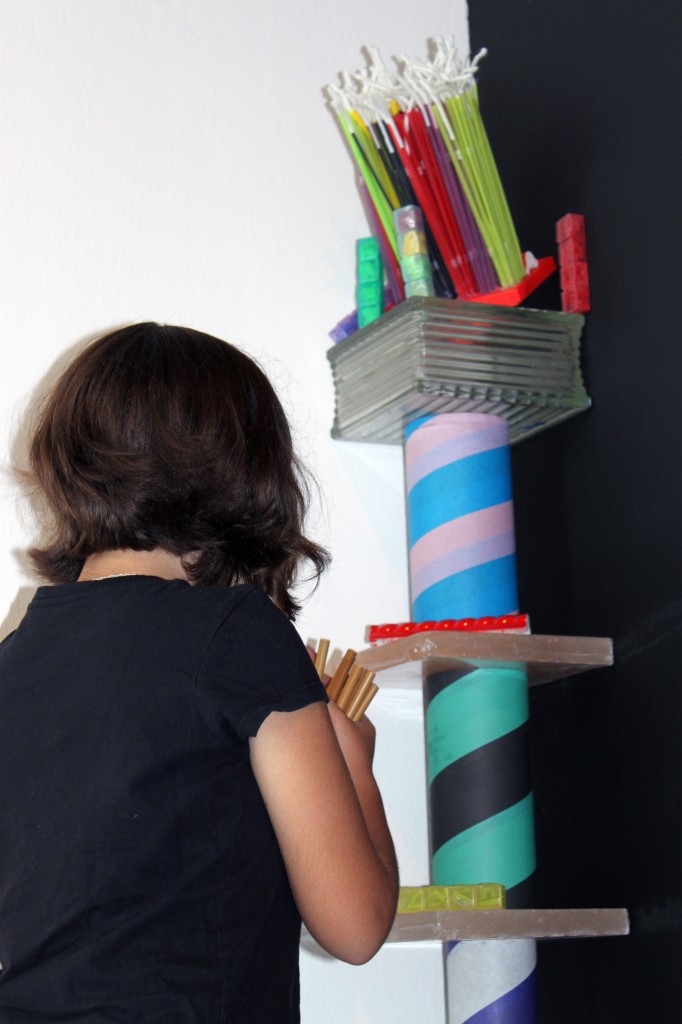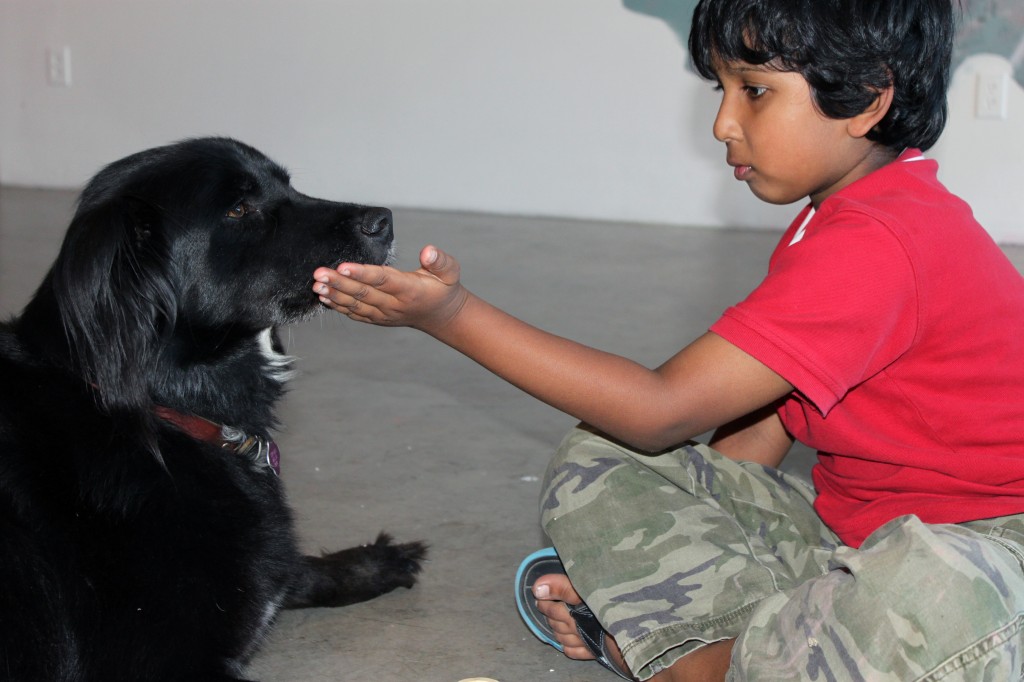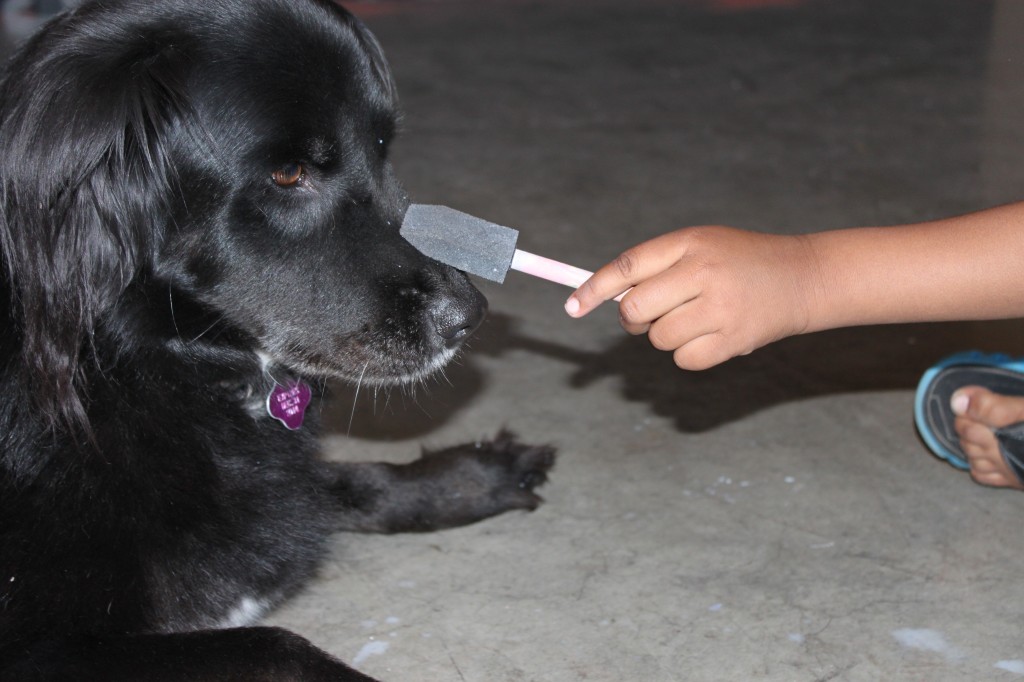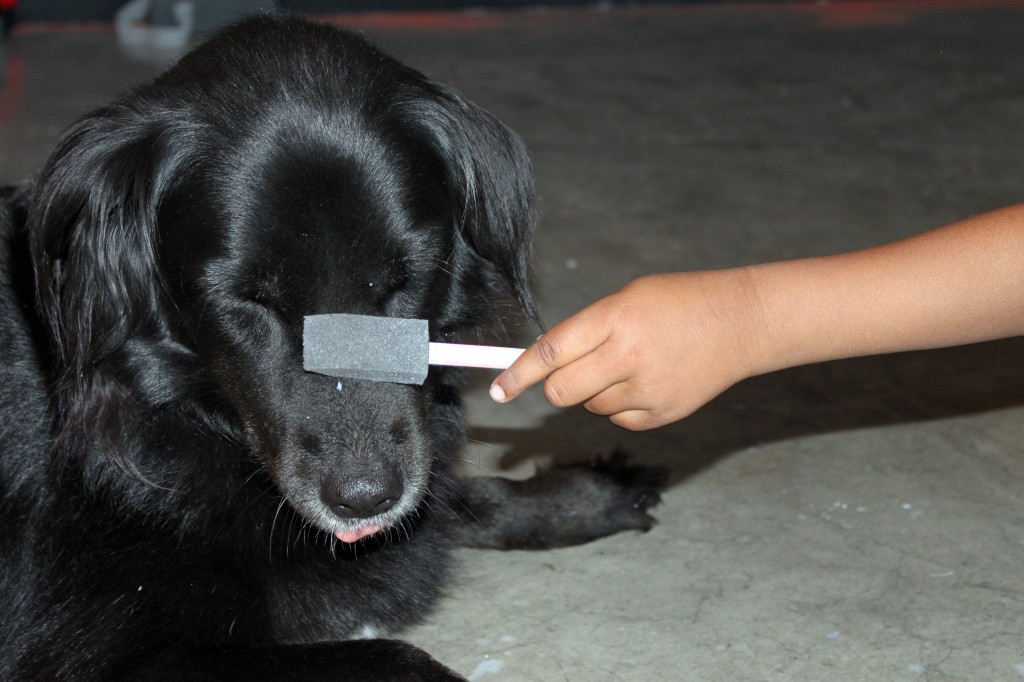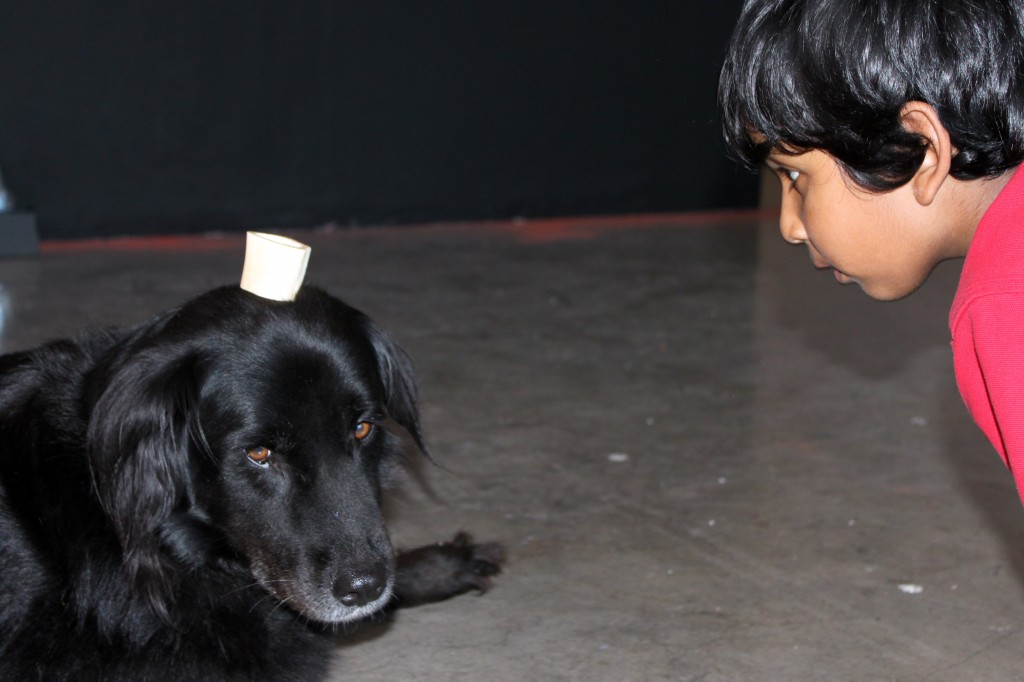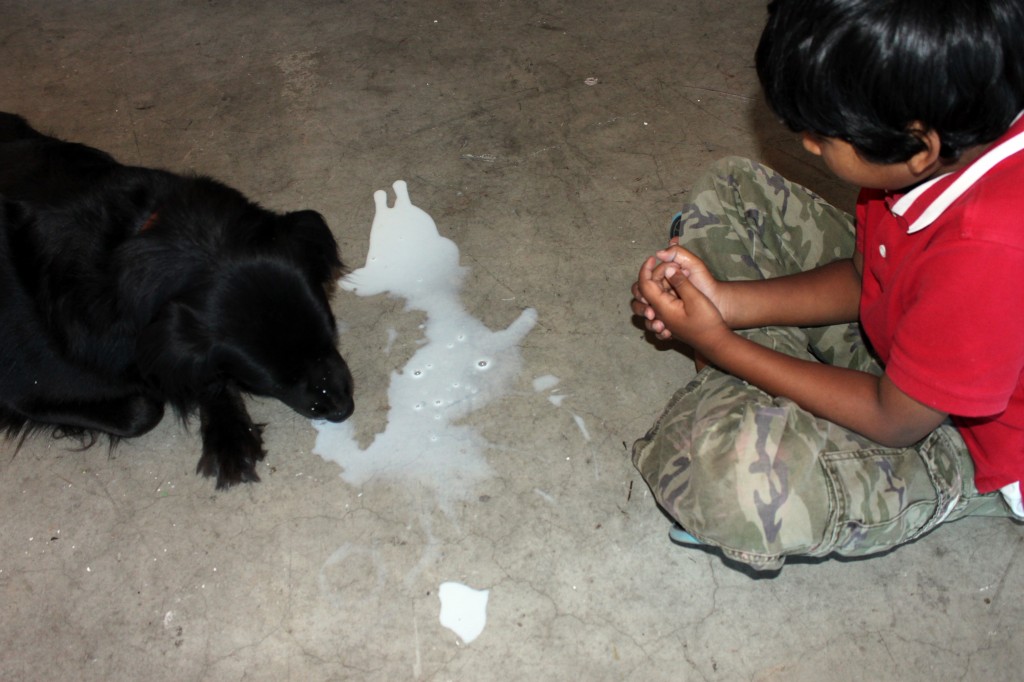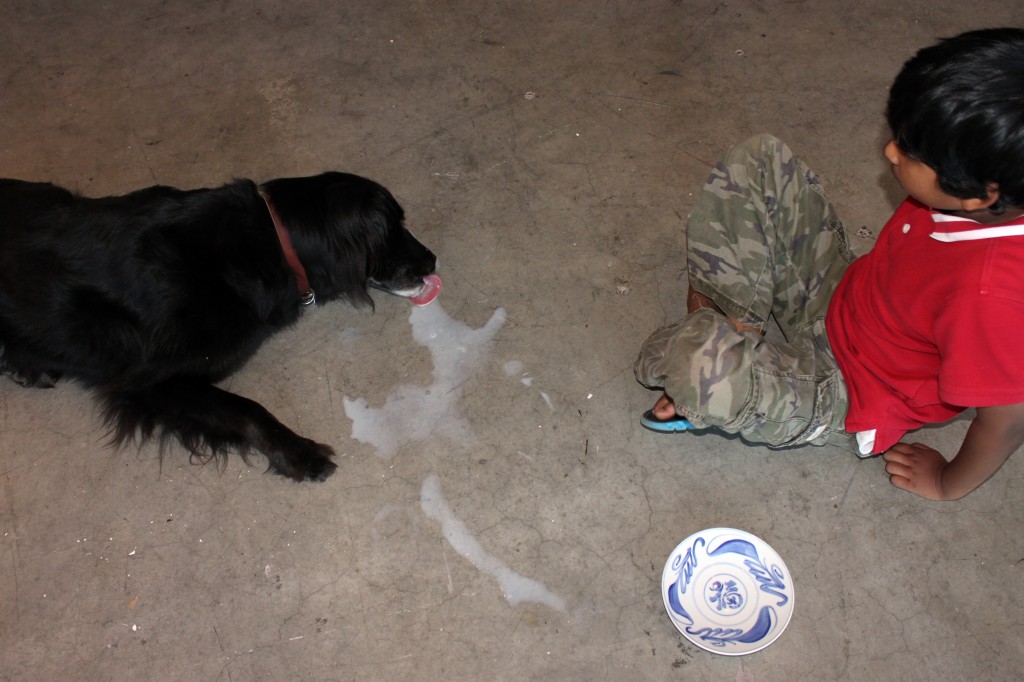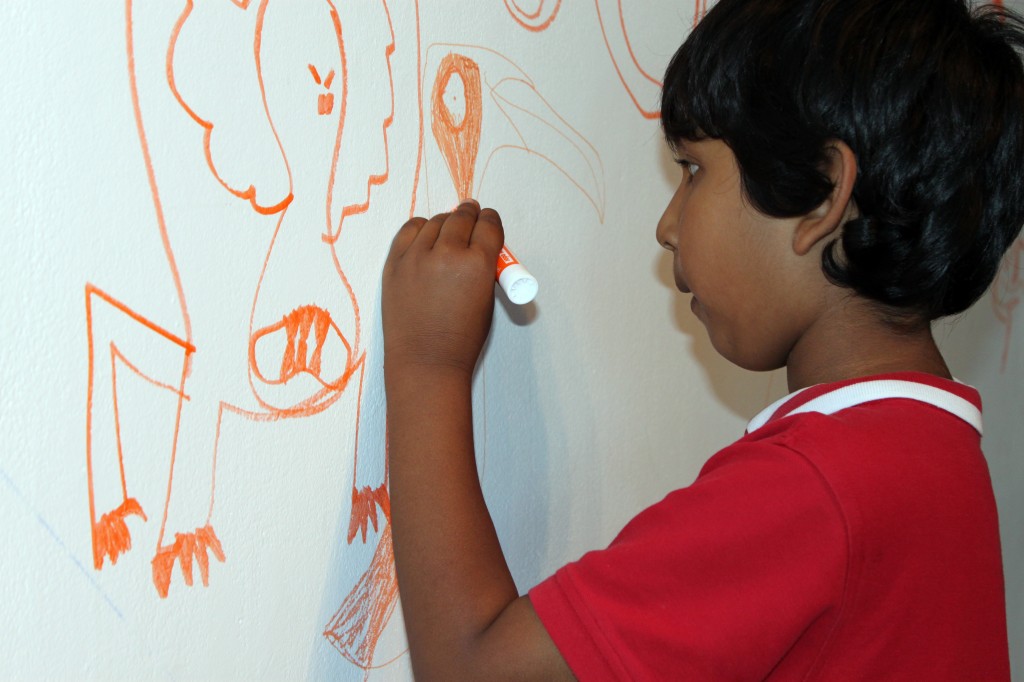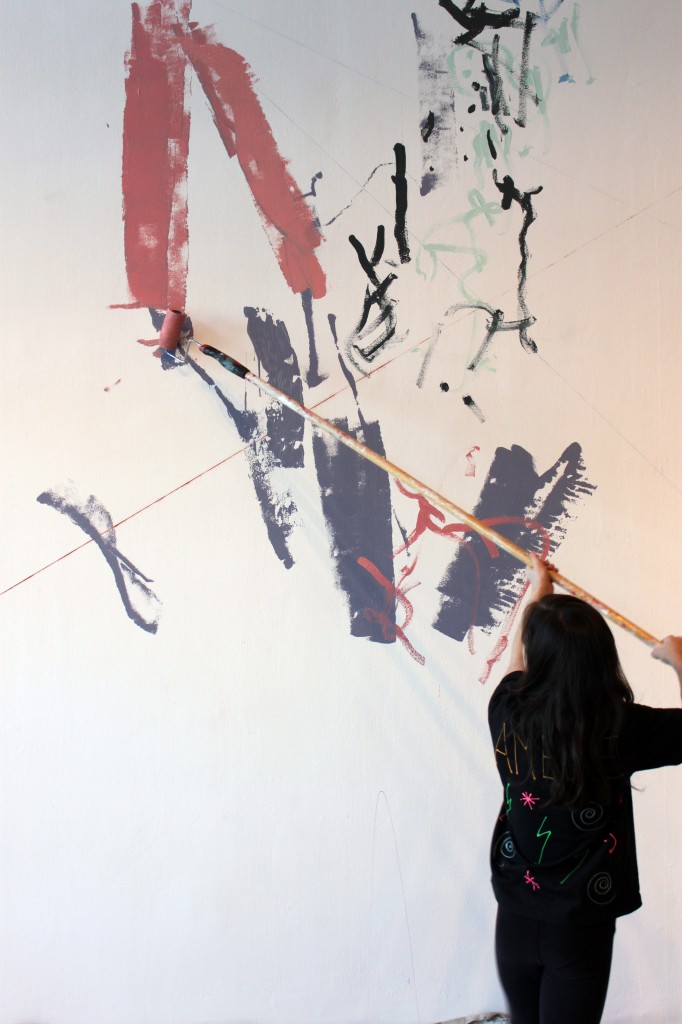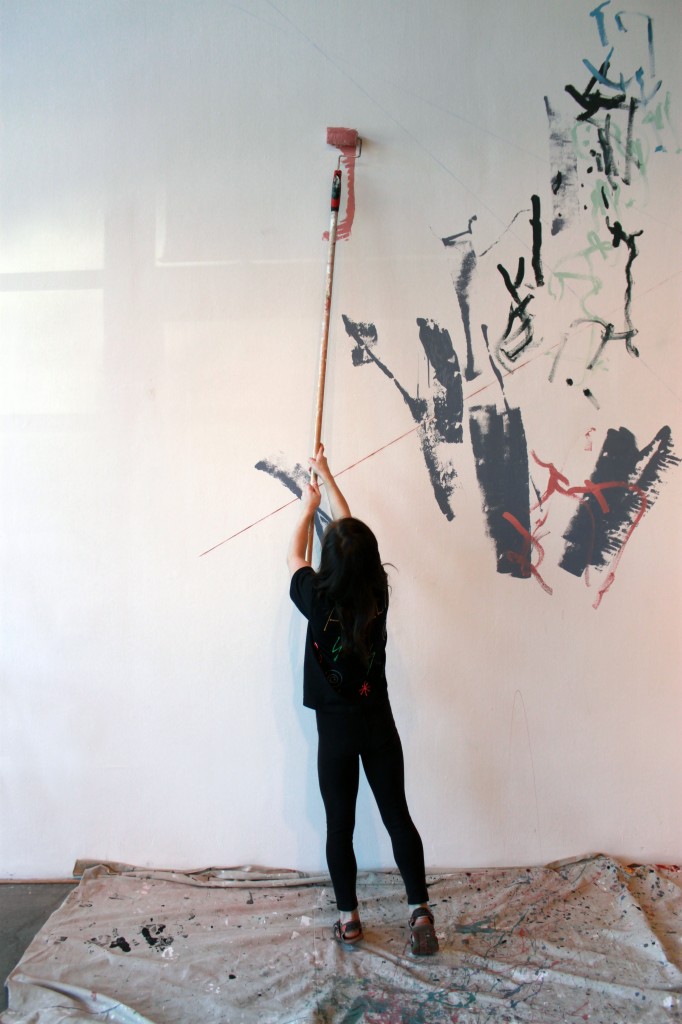We’ve received a few postcards sent to us by grunt volunteers and staff who are travelling this summer.
Day 2 – Isabelle – PLAY FALL REST DANCE
Isabelle is the dedicated sculpture / assembler of the Grunt group.
She loves colour, shape, pattern and texture.
She has a hard time with figuring out what to do.
I asked her to choose a few items…spontaneously.
Then we hung out on the floor and simply played with the materials.
Eventually a tower rose out of the chaos.
This was a brave balancing act that Isabelle carefully pursued .
She never gave up or got frustrated.
This is an amazing 8 foot tower that when looked at in person is totally a psychedelic optical mind game.
Read more here
Day 2 – Deshik -PLAY FALL REST DANCE
Deshik does not have any pets.
Yet all he talks about and draws are animals and birds.
I promised I would bring my dog (Negrita) to the gallery so Deshik could meet her.
 Upon meeting the dog Deshik spent the first 20 minutes running in a circle around her.
Upon meeting the dog Deshik spent the first 20 minutes running in a circle around her.
Then he spent a full hour examining Negritas fur, teeth, nose, inside of ears, etc.
Negrita is infinitely patient and gentle.
She is so mellow that she would often lay her head down amidst poking and prodding.
When this happened Deshik would ask “Is she dead now?”
Deshik started to get objects from the materials room and test them out on Negrita.
Basically this was the art process / project of the day.
I just let it unfold.
My favorite…..a bone balanced on dogs head.
Then he wanted to feed her.
I brought him half a carton of milk.
Deshik grabbed it and poured it directly on the gallery floor.
Fascinated, Deshik watched Negrita gently lap up the spilt milk.
He observed that as she licked away the white liquid “…….It makes a moving drawing!”
For the last hour Deshik gets to drawing directly on the wall.
He draws animals. He draws quickly and with full assurance in his sweeping lines. 
The whole while he talks about Negrita and his observations.
Mostly he repeated that Negrita was “…..so unusual cause she’s got a mane like a lion and fluffer ears.”
[Announcement] gruntCraft
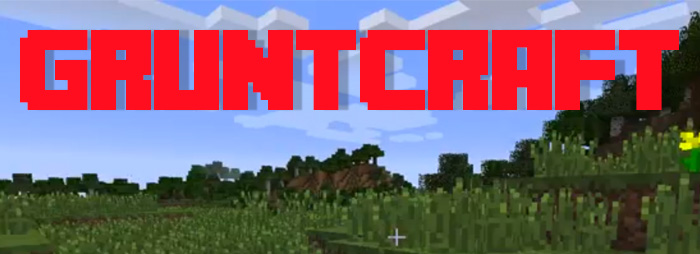
grunt gallery is excited to announce a new youth arts engagement project entitled, gruntCraft
The project uses the popular computer game Minecraft as a tool and studio to create new and incredible structures in a virtual world. Youth participants will be mentored by professional artists to explore their creative processes and discover new ways to approach art making through a collaborative, online, video game environment.
Follow the development of the virtual studio by subscribing to gruntCraft’s YouTube site. As part of the studio program, youth studio members (aged 11-18) will have access to professional artists feedback and mentorship, 3D printing workshops, and opportunities to participate in studio open houses at grunt gallery.
gruntCraft will occur from July to December 2014 and is led by artist and project manager, Demian Petryshyn. Please visit gruntcraft.ca for more information and project updates.
We’re on the lookout for youth participants and volunteers.
Feel free to check out the studio server at: 50.23.129.103. If you are interested in becoming a youth studio member (aged 11-18) or would like to get involved as a volunteer, please contact Demian at gruntcraftvancouver@gmail.com or visit gruntcraft.ca for more info (coming soon).
1st Day- Amelie PLAY FALL REST DANCE
Amelie was the first and only participant to use the tall ladder.
Being an accomplished gymnast might be why she has no fear of heights.
Amelie has an extremely shy disposition yet there is a fierce strength to her.
Her style was fragile yet focused and determined.
Besides using paint she made a few deep red chalk lines with a plumb line.
At one point she looked at her hands intensely and seemed concerned.
Amelie thought they were bleeding.
I check it out and we concluded it was red chalk dust.
She looked up at the wall, smiled and whispered “The wall is bleeding.”
Amelie is termed ‘medically complex’.
‘Medically Complex’ is a term used for babies born with a rare and undefinable disorder.
Multiple life threatening illnesses will seriously affect the person in undetermined ways.
8 to 10 years ago medicine and medical procedures were not able to keep medically complex babies alive.
Amelie’s heart is severely affected as well as her white blood cell count.
She has had numerous open heart surgeries since birth and catches phenomena regularly.
Yet she has defeated doctors prognosis’s of having completely flaccid muscular structure by 8 years old.
She is 9 and ripped!
Play, Fall, Rest, Dance is an exhibition project by Valerie Salez. The artist works with children with disabilities to help them explore the creative process of installation making. The exhibition runs from June 3 to July 5, 2014. The public is welcome to visit grunt gallery to see the installations that will continuously change and evolve over the course of the project.
Read more here.
Vancouver Sun – Vancouver invests in stable space for arts groups
BY JEFF LEE, VANCOUVER SUN JUNE 5, 2014

VANCOUVER — City hall is bringing some relief to Vancouver’s embattled arts community, which has for years complained about a lack of stable accommodation, with a $5-million commitment to help groups find, buy or rent their own space.
Most of the money — $4.5 million — is coming from community amenity contributions the city collected from a developer in return for approving the controversial Rize Alliance tower in Mount Pleasant. Those funds will help four groups — Western Front, grunt gallery, Arts Factory and a combination of VIVO Media Arts and C-Space, to buy or rent their own space.
The city is also putting up one-third of a $900,000 seed fund to the Toronto Artscape group create a B.C. affiliate that will emulate its successful endeavours to find workspace and sometimes living space for artists. The $300,000 in Artscape money, coming from the city’s Innovation Fund, is contingent upon matching dollars from the Vancity Community Foundation and the McConnell Foundation.
In a report going to council Wednesday, city staff say the funding from the Rize development will help stabilize arts groups in the Mount Pleasant neighbourhood, one of the city’s “artistic hubs.” They note that over 50 cultural non-profits operate in the neighbourhood, but they face increased pressure from urban redevelopment.
Under the proposal, the city will give out $2.2 million to Western Front, grunt gallery and Arts Factory to secure or enhance their existing facilities. Of that, Western Front gets $1.5 million, grunt gallery $400,000 and Arts Factory $300,000…
Background / ThisPlace web launch

THURSDAY MAY 29
grunt gallery announces the official launch of the Background / ThisPlace website.
Background / ThisPlace is a collaborative project that revisits a conceptual project created by Michael de Courcy in 1972, entitled Background/Vancouver. Forty years later, artists Emilio Rojas, Guadalupe Martinez, and Igor Santizointersect the original project with new ideas regarding identity, history, and social intervention.
Join us at grunt gallery for the launch reception, the newly created website will be accessible in the gruntKitchen Media Lab. Artist Eric Angus will be presenting his new live audiovisual performance 49.2500° N, 123.1000° W built around audiovisual documentation from across the greater vancouver area.
thisplace.grunt.ca/
grunt’s picks | May 20
1) [Vancouver] If you didn’t get a chance to stop by grunt gallery for the exhibition “10 Years of State of Emergency” then fear not. You can still check out the co-exhibition over at Gallery Gachet which runs until Sunday May 25.

Catch up with ATSA on this interview written by Maria Fedorove and Gizem Sozen.
2) [Vancouver] Last week, grunt gallery had a get-together to introduce new staff-members and volunteers. Robert Chaplin stopped by and told us about his exhibition that opened last week, About Time. It’s at the Unit/Pitt gallery until June 28.
3) [Vancouver] Claiming Spaces: Voices of Urban Aboriginal Youth is opening at the Museum of Anthropology on June 1, 2014. The show includes work by a number of indigenous youth artists, it’s probably a good idea to keep an eye on some of these up-and-coming youth artists. The show is curated by Pam Brown and curatorial assisted by Elle-Máijá Tailfeathers. The opening reception has an incredible line-up of musicians and DJs including Skookum Sound System, check it out here.

http://moa.ubc.ca/experience/exhibit_details.php?id=1335
4) [Vancouver] We’re pretty amazed by the work produced for the Year of Reconciliation project. Many will recognize Sonny Assu’s graphic style on bus shelter posters around the city. But perhaps you’re not as familiar with Gabrielle Hill’s work, she’s involved with a project that includes Tania Willard and Peter Morin. We’re also looking forward to getting downtown to see Krista Belle Stewart’s, Her Story.
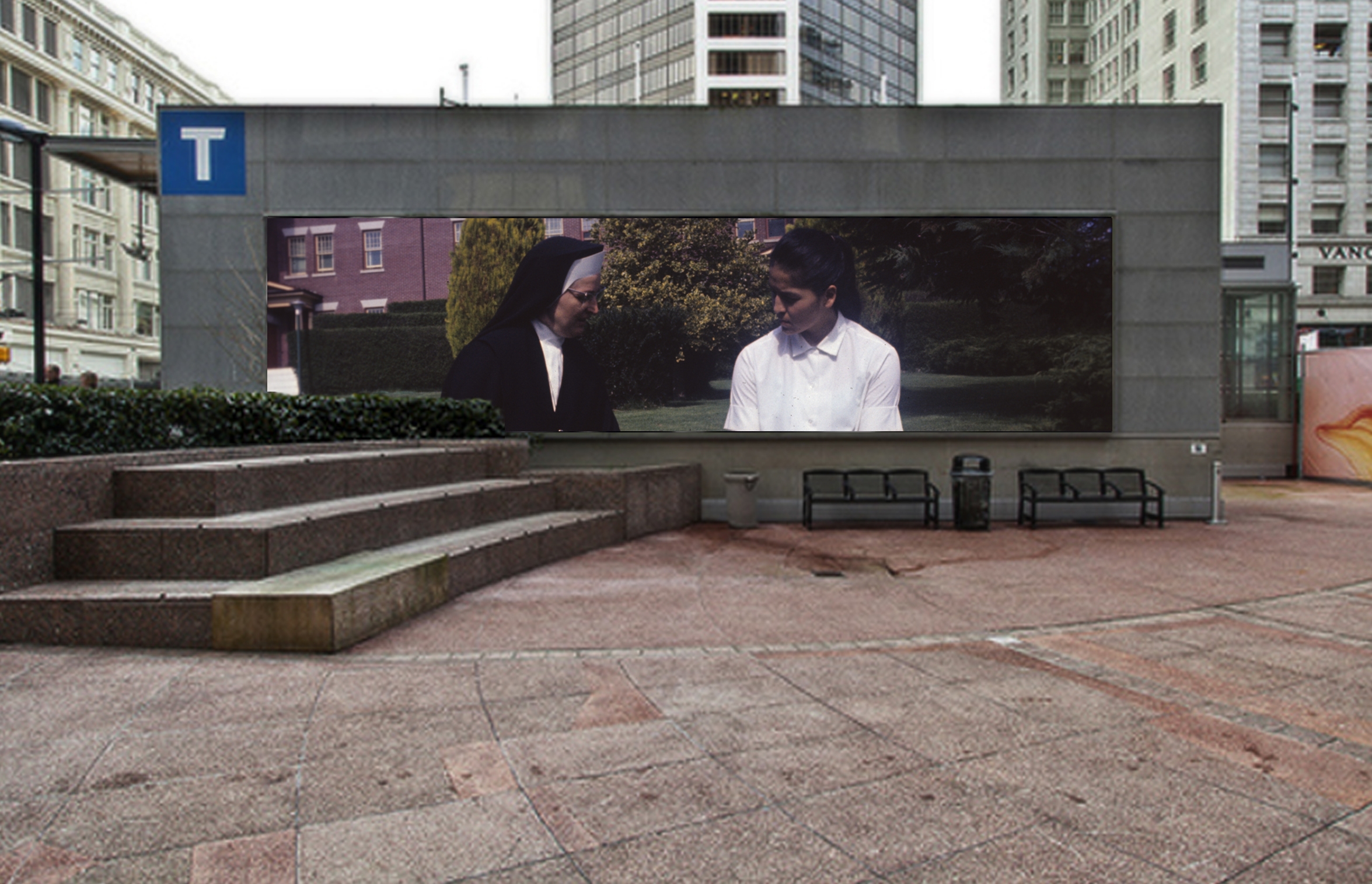
5) [Toronto] And to wrap it up, we truly wish we were in Toronto for Rebecca Belmore‘s solo exhibition, Kwe. Did you see it? Let us know on Facebook or Twitter.

Read this recent interview with Rebecca by The Star.
Listen to Rebecca Belmore interviewed on Q CBC.
Interview with ATSA by Maria Fedorova
Interview by Gizem Sözen & Maria Fedorova
“Maria and I are both interested in the intersection of the arts and politics. After seeing ATSA’s work at grunt, many questions were raised for both of us. This is why we decided to interview Annie and Pierre together.
First of all, ATSA stands for Action Terroriste Socialement Acceptable (Socially Acceptable Terrorist Action). Their interventionist art practices fall under what they refer to as ‘art terrorism’. We were curious what this meant for them. Another big question for us was what they¬—as intervention artists who position themselves where the heart of the street beats—thought about exhibiting at an art gallery.
A third interesting point for us to consider was their inclusion of object-based art forms in the exhibition, rather than relying solely on videos and photographs for giving an affect-based sense of their work on the street.
I could not be there in person, but I worked with Maria to develop the questions and she was able to meet with Annie and Pierre to hear what they had to say regarding their touring exhibition.” – Gizem Sözen
Maria Fedorova:
I want to start with the aesthetics of intervention both in the physical space and in the media realm, as it seems to be very significant for your art. Can you elaborate on how political and social intervention plays a role in your art practice?
Annie Roy:
I think we see ourselves mostly as citizens and we want to speak to our co-citizens. I think if there are more people who want things to change, politicians would have no choice but to take action. We invite politicians to our events, to be part of them, but we don’t do lobbying or we are not exactly activists. Our work is more about a reflection on the social mood or social perception of the problems and we aim to empower citizens for being part of a change.
Maria Fedorova:
So you don’t aim to provoke?
Pierre Allard:
Yes, as artists, we think it is very important that it takes place in public space, to bring provocative images, to shock people. When we work outside on the street and when we bring strong images, what we are trying to reveal gets deeper in the public’s soul. In our art, we try to bring the problems very close to you. So we try to go with the emotions, we try to talk to you. A lot of our work is done afterwards. People who have seen our work, when they leave, they keep thinking about it because of the emotion they had in their encounter with the work.
Maria Fedorova:
Who are you targeting with your artwork— community or governmental authorities?
Annie Roy:
Our co-citizens, and some of them are politicians. Some of them will be sensitive about the same values and some others won’t. But we are apolitical in the sense that we aren’t supporting one political party. We are not into political parties; we are mostly into values.
Pierre Allard:
We work with citizens but at the same time when we are organizing big events, we try to invite politicians so they have to confront the people. In Montreal, there is lots of ticketing, for example; if you spit on the street you get big fines. Some homeless people get over $12,000 [in] fines while they are living on the street! One year, we made a project with another artist regarding the ticketing. We invited the mayor, so the mayor had to take a position.
Art sometimes functions as public voice, as a way to put the problem in media and to make sure people know about it and then that puts pressure on politicians.
Maria Fedorova:
So ATSA goes for socially acceptable terrorist action. We feel that there is tension between “terrorism” versus “socially accepted,” raising public awareness through open critique of governmental policies versus the way you are accepted by governmental institutions. In today’s talk at grunt gallery, you also talked about how you collaborated with Canadian Forces for a project. We are surprised that Canadian Forces agreed to work with you with that name.
Annie Roy:
No, they didn’t. They just thought we are two individuals that wanted to do a refugee camp and it would help them to have a good image. They didn’t know that we were artists, so we convinced them to do this with us without telling them we would have a critical discourse against army. So that was our only terrorism, not to say everything to manage getting what we needed. But later, in the media, we could say, “Look how much money we put in armament instead of taking care of poverty; we could have peace in the world if economy was not depending on war economy.”
Maria Fedorova:
What was the reaction after you announced openly that you did this? Did you receive a reaction from the army or any other authority?
Pierre Allard:
Before they knew we were called ATSA, they wanted to make a big press conference. We were feeling that we were losing the project, they were taking it over. After they learned our collective’s name, they dropped that. That was really good indeed, because I was bit scared that they could manipulate the image of the project. After that we worked with the fire department. Every time, we feel a bit of tension due to our name, but after we explain what we do people want to be part of it.
Annie Roy:
When 2001 occurred, we said, oh my god, are we going to continue with a name like that? We asked the jury and Canada Council and they said you should continue with your name. If you want to speak about how bad our problems are, you have to take a word as strong as the issue you want to talk about. Of course, it doesn’t mean that we think that terrorism is ok, it is the opposite. What we do is art terrorism.
Maria Fedorova:
I was just curious because there are many art collectives in Russia, but this collaboration would never be possible there.
Pierre Allard:
But now with the Canadian army, this would not be possible either. Back then, the Canadian Army was a peaceful army. They were peacekeepers in Bosnia at the time.
Maria Fedorova:
Now I want to talk a bit about this exhibition. Interventionist art has always explored public space and its social and political modalities. ATSA as an art collective aims to address social and political issues, and you use public settings as your site of engagement. For this show, however, you are coming back to a more traditional gallery setting. Can you talk about that and also talk about your experience in a gallery setting in comparison to your experiences in public space?
Annie Roy:
For us, our work is in the street. When we do an art show outside the street, it is in order to look back to what we did on the street, as a second level, in order to prolong the ephemeral experience in the street into a real object. And this object makes us to speak about the street again. So the object becomes a tool. Making an artwork for the gallery is, for us, a way to digest what we produced on the street. It is maybe a way to crystallize something that is very ephemeral.
Pierre Allard:
If we think about found objects that we have been working with or objects that have been on the street with us, they have a story of their own since they were there, so that is what we like about them. One of them is a cover of a bucket for a soup. We did serve soup there with it, so it was part of the project.
Annie Roy:
It is a bit romantic.
Pierre Allard:
We have produced so much in 12–15 years. We produced so much art in collaboration with other artists and homeless people. With this exhibition, we wanted to show all of these. To see this art in the camp or on the street is different because there you are overwhelmed with the distress of the reality. Now here, seeing the exhibition and talking about homelessness, it is easier to an extent to understand the work since you are bit withdrawn from the reality.
Annie Roy:
Here you see the art for the art, so it is another kind of experience, an experience more protected, calmer, more isolated from the problem. But because you are bit detached from it, you may think calmly, in a different way.
Pierre Allard:
And since there are over 25 works and there are so many layers, you can have a different perspective of the same subject. So the exhibition is working pretty fine, I could say.
Maria Fedorova:
So speaking about the ephemerality of your work on the street, for this exhibition you decided to show object-oriented art works, which is not a conventional way of documenting process-based art or ephemeral art practices. Of course you do have video and photographs, but you are also displaying blankets, for example. It is interesting: we think that you are trying to communicate the experience that was out there. Could you comment on that?
Annie Roy:
It is about a mix of an emotion you can feel from an art piece. It is a balance between to know what happened and also almost just having a sense of the ambiance. Also they reveal the contrast of emotions we experience at the camp—lots of difficulties but at the same time lots of joy for being there and being together, eating well. So it is a contrast between joy and distress, political difficulties to make it happen and our happiness to offer such a thing. We try to make an art piece that speaks about the project, speaks about our intention behind the project, like the blanket piece.
Maria Fedorova:
My last question is about the oven, La Banque a Bas. I think it is a great metaphor, this connection to the ATM and the way you installed it. So you installed it in front of the Museum of Contemporary Art in Montreal. Could you please comment on this decision? And talk about your collaboration with the museum?
Pierre Allard:
It was about the state of art in Montreal; that was the show. There was a lot of criticism about the fact that none of the artists who were doing street work were in the show. Also the museum was at Place des Arts. So this is the biggest place for arts, it is downtown and facing all the banks.
Maria Fedorova:
So you collaborated with the museum after that?
Annie Roy:
Mostly with the people in the communication department. Firstly, we learned that the director of the museum was an ex-Jesuit priest. So when he saw our piece, it moved him in a humanitarian way. And I think he thought, “Yes, they are right, there is nothing about what is happening in the public space,” and I think in the end they were happy.
Pierre Allard:
Yes, it worked out, but I know that we disturbed some of the curators of the museum.
Annie Roy:
Of course, because we criticized their choices. And some artists also probably were not so happy because we took a lot of media attention doing it.
Pierre Allard:
Closing of the La Banque that year made a big event in the museum. Then it allowed us to do a new project after that. And then we changed location but they still gave us some services in communication the year after, when we were not there anymore.
Maria Fedorova:
It was also part of your ideology to be there on the street and not somewhere else.
Annie Roy:
Yes, we have to be where people are and where it is central. That is where it hurts.
10 Years of State of Emergency is co-presented with Gallery Gachet. The exhibition at grunt gallery runs until May 17th, the exhibition at Gachet runs until May 24th. grunt gallery is open Tuesday-Saturday from noon-5pm.
Read more about the exhibition here.
About Maria Fedorova:
Photographer, curator, Maria Fedorova holds a BA in Linguistics and Communications from International University in Moscow and is currently a Master Candidate at the School of Interactive Arts + Technology at Simon Fraser University, Canada. Maria’s interests include Russian and international new media art with a particular focus on performance and video as well as politically and socially engaged practices. She is a co-founder of ARTinVANCOUVER, social media and cultural platform that represents an intersection of art, design, technology.
grunt Board // David Khang: Wrong Places
David Khang is a board member at grunt gallery. Check out his upcoming exhibition in Toronto, Ontario.
Wrong Place / Mauvais Endroit / Lugar Incorrecto /틀린 장소
UPCOMING exhibition @ A Space Gallery
401 Richmond St., Suite 110, Toronto Ontario, M5V 3A8, (416)979-9633, Tuesday to Friday, 11-5, Saturday 12-5.
Exhibition: May 16 – June 14, 2014
Opening reception: Friday May 16, 6 – 8pm
; Performance: 7pm
Exhibition essay by Dina Al-Kassim
Wrong Place / Mauvais Endroit / Lugar Incorrecto /틀린 장소 is an ongoing series of site-specific public works that are performative.
By researching geopolitical histories, seemingly disparate political events are ‘remixed’ – cross-culturally and linguistically. Performed in various international sites – Nicosia (Cyprus), Santiago (Chile), Valdivia (Chile), Mexico City (Mexico), Edmonton and Montréal – each iteration centres on an iconic public speech, which is translated, then enunciated in multiple languages.
The result, at once dissonant and consonant, is intended to question our historic amnesia, and to trigger a re-imagining of their historical interconnectedness and continuing relevance to contemporary culture and geopolitics. At A Space Gallery, the work becomes a multimedia installation based on the original performances: painted military fatigue, flag-like photographs, a bicycle-powered mini-tank, and videodocumentation of the original site-specific performances.


 Wrong Place / Mauvais Endroit / Lugar Incorrecto / 틀린 장소 2014
Wrong Place / Mauvais Endroit / Lugar Incorrecto / 틀린 장소 2014
